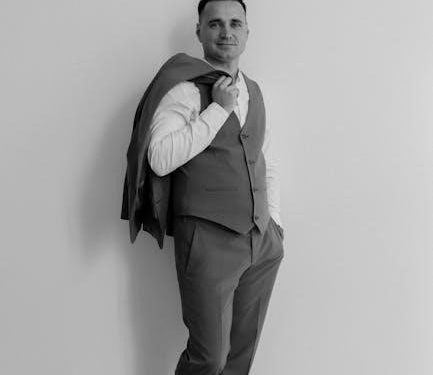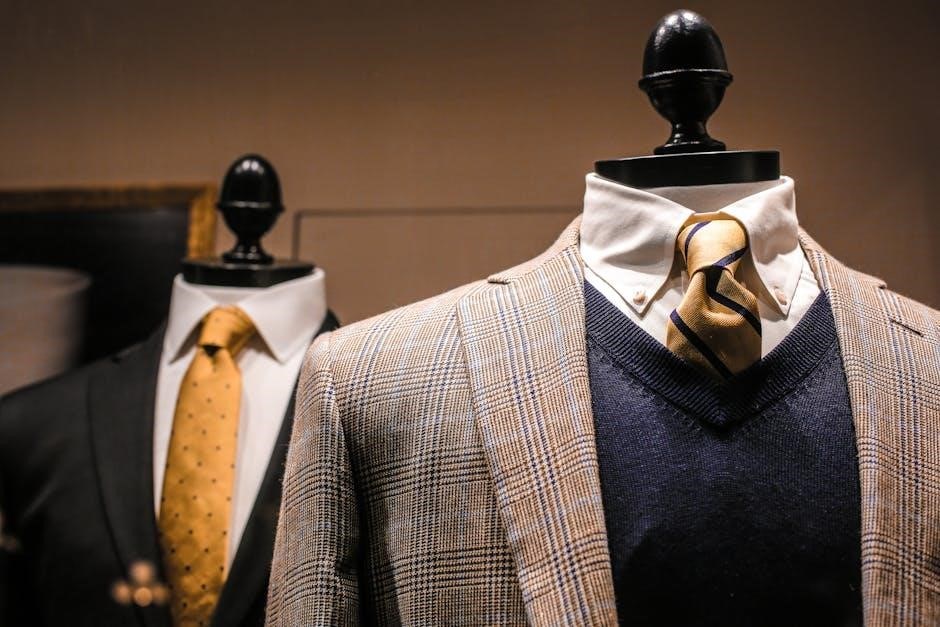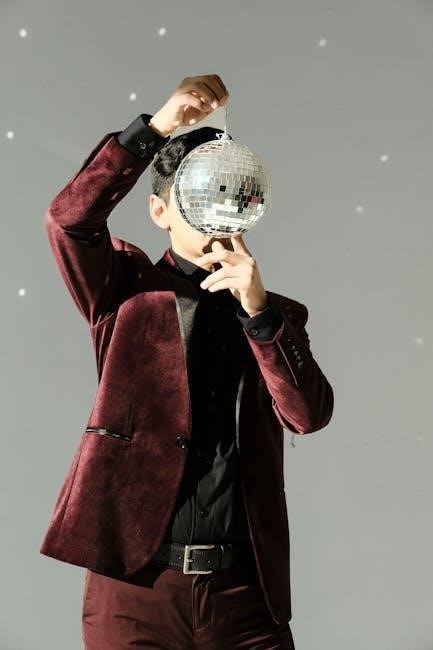
Understanding the Importance of Suit Jacket Length
The suit jacket length is crucial for a polished appearance, ensuring balance and proportion. It should cover the torso and hips, creating a streamlined silhouette. Proper length enhances fit, while incorrect measurements can distort the frame and overall style;

1.1 How Jacket Length Affects the Overall Fit

The length of a suit jacket plays a pivotal role in achieving a well-fitted appearance. A jacket that is too short can expose the shirt and create an unbalanced look, while one that is too long may overwhelm the frame. Proper length ensures the jacket sits naturally on the body, complementing the torso’s shape. It should cover the hips and align with the waistline to maintain proportion. Incorrect jacket length can lead to issues like shoulder sag or shoulder bite, which distort the fit. For shorter men, a slightly shorter jacket length is often recommended to avoid overwhelming the frame, while taller individuals may require longer styles. Ultimately, the jacket’s length must harmonize with the wearer’s body type and posture to ensure a polished, professional look. Striking the right balance is essential for a sharp, tailored appearance.
1.2 The Role of Jacket Length in Proportion and Balance
The jacket length plays a vital role in achieving proportion and balance in a suit. A well-fitted jacket ensures the wearer appears streamlined, with the garment creating a harmonious relationship between the torso and legs. For shorter individuals, a slightly shorter jacket can create the illusion of longer legs, while taller men may opt for a longer jacket to balance their frame. The jacket should ideally cover the buttocks to maintain symmetry, avoiding a look that feels either boxy or disproportionately short. Proper proportion ensures the suit complements the body rather than overwhelming or shrinking it. Balancing the jacket length with pant length is equally important, as mismatched proportions can disrupt the overall aesthetic. Ultimately, the right jacket length ensures a polished, cohesive appearance that enhances the wearer’s natural silhouette.

Determining the Correct Jacket Length
To determine the ideal jacket length, measure from the base of the neck to the top of the thigh or hip bone. Ensure the jacket covers the buttocks for proportion and balance.
2.1 Measuring for the Ideal Jacket Length
Measuring for the ideal jacket length is essential to ensure a well-fitted suit. Start by standing upright to maintain proper posture, as slouching can lead to inaccurate measurements. The measurement typically begins at the base of the neck, aligned with the spine, and extends downward to the desired length. The jacket should cover the buttocks, with the hem reaching just below them for a balanced look.
Consider your height and body type; shorter individuals may prefer a slightly shorter jacket, while taller individuals can opt for a longer style. Additionally, the jacket length should align with the zipper of your pants when standing upright, ensuring harmony between the jacket and trousers. Take into account the style of the jacket—slim-fit styles may be shorter, while classic styles are longer.
Measure from the shoulder down to the hip bone or the top of the thighs, ensuring the jacket complements your torso length. For accurate results, measure without bulky clothing and refer to standard measurement charts based on height and body type. Adjustments can be made for personal style or specific needs, ensuring the jacket length contributes to a proportional and polished appearance.
2.2 How Body Type Influences Jacket Length
Body type plays a significant role in determining the ideal jacket length. Taller individuals often benefit from slightly longer jackets to maintain balance, while shorter men may prefer shorter jackets to avoid overwhelming their frame. Athletic builds may require jackets with broader shoulders and a slightly longer length to accommodate their physique. Conversely, slimmer individuals can opt for more tailored, fitted jackets that create a streamlined look. For those with a pear-shaped body, a slightly longer jacket can help elongate the torso and balance proportions. Understanding your body type and how it interacts with jacket length is essential for achieving a polished, well-fitted appearance. This ensures the jacket complements your natural shape rather than working against it, creating a harmonious and confident look.
2.3 The Role of Personal Style in Choosing Jacket Length
Personal style plays a significant role in determining the ideal jacket length, as it allows individuals to express their aesthetic preferences. While traditional guidelines suggest covering the hips for a balanced look, modern fashion often embraces shorter or longer lengths for a stylish edge. Some opt for a shorter jacket to create a slimmer silhouette, while others prefer a longer cut for a more formal or classic appearance. Body type and personal taste should both influence the decision, ensuring the jacket complements the wearer’s proportions. For instance, taller individuals might favor longer jackets to maintain harmony, while shorter men may prefer shorter lengths to avoid overwhelming their frame. Ultimately, personal style should guide the choice, blending practicality with individual flair to create a cohesive and confident look.

Common Mistakes to Avoid
Avoid jackets that are too short or too long, as they disrupt balance. Ensure the jacket covers the buttocks but doesn’t overwhelm the frame. Pants length also impacts the overall fit.
3.1 Jackets That Are Too Short or Too Long
A jacket that is too short can make the torso appear longer and disrupt the balance of the suit. It may also fail to cover the hips properly, creating an unflattering silhouette. On the other hand, a jacket that is too long can overwhelm the frame, making the wearer appear shorter or boxier. Both extremes draw attention away from the overall tailored look, emphasizing fit issues rather than style.
Ill-fitting jacket length can also affect how other elements of the suit align. For example, sleeves may appear out of proportion, and the buttons or vents may sit awkwardly on the body. Ensuring the jacket length is neither too short nor too long is essential for maintaining harmony in the suit’s design and creating a polished, professional appearance.
Measuring correctly and considering personal proportions are key to avoiding these common mistakes. A well-fitted jacket strikes the perfect balance, enhancing both style and confidence.
3.2 The Impact of Pants Length on Jacket Fit
The length of your pants significantly influences how well your suit jacket fits. If your pants are too long, they can create a disproportionate look, making the jacket appear shorter than it is. Conversely, pants that are too short may expose too much of your shirt or socks, disrupting the balanced aesthetic. The ideal pant length should lightly graze the top of your shoes, creating a seamless line from jacket to footwear. When pants are properly tailored, they complement the jacket’s length, ensuring a cohesive and polished appearance. Ignoring this detail can undermine the overall fit, even if the jacket itself is perfectly sized. Balancing pant and jacket lengths is essential for achieving a professional, put-together look.
A well-fitted suit jacket enhances confidence and style. Ensure the length complements your torso and aligns with your pants for a balanced, polished look. Proper fit is key to sophistication and comfort.
4.1 Final Tips for a Perfectly Fitted Suit Jacket
A perfectly fitted suit jacket is the cornerstone of a polished, professional appearance. To achieve this, ensure the jacket covers your torso and hips proportionally, with the hem resting just below your buttocks. The shoulders should align seamlessly with your natural shoulder line, avoiding any sagging or tightness; Sleeves should expose about half an inch of your shirt cuff, creating balance. For shorter men, a slightly shorter jacket can elongate the torso, while taller individuals may opt for longer styles to maintain harmony. Personal style plays a role, but prioritizing fit is essential. Consider professional tailoring for adjustments, as even small tweaks can enhance comfort and aesthetics. Pairing the jacket with appropriately fitted pants and accessories completes the look. Remember, a well-fitted suit jacket not only boosts confidence but also projects professionalism and attention to detail.